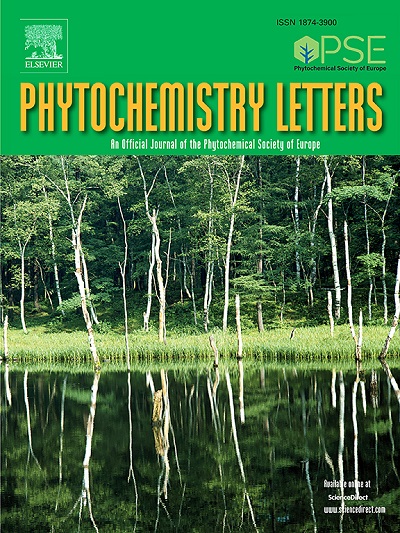从薯蓣中分离出的内生镰刀菌 L33 的 α-吡喃酮衍生物
IF 1.3
4区 生物学
Q4 CHEMISTRY, MEDICINAL
引用次数: 0
摘要
从从薯蓣叶中分离出的内生真菌 Fusarium sp. L33 中分离出了两种新的α-吡喃酮衍生物 fusaripyrones C 和 D(1 和 2),以及六种已知化合物,即 phomapyrone C(3)、fusarilactone A(4)、pleospyrone D(5)、5-羟基-7-(2′-羟基丙基)-2-甲基-Chromone(6)、苯乙酸(7)和对羟基苯乙酸(8)。L33 中分离出来。通过核磁共振波谱、HRESIMS、光学旋转实验和单晶 X 射线衍射分析阐明了它们的结构。评估了化合物 2、3 和 6 对五种选定的人类肿瘤细胞系的细胞毒活性。本文章由计算机程序翻译,如有差异,请以英文原文为准。
α-pyrone derivatives from the endophytic Fusarium sp. L33 isolated from Dioscorea opposita
Two new α-pyrone derivatives, fusaripyrones C and D (1 and 2), along with six known compounds, namely phomapyrone C (3), fusarilactone A (4), pleospyrone D (5), 5-hydroxy-7-(2′-hydroxypropyl)-2-methyl-chromone (6), phenylacetic acid (7), and p-hydroxyphenylacetic acid (8) were isolated from Fusarium sp. L33, an endophytic fungus isolated from the leaves of Dioscorea opposita. Their structures were elucidated by NMR spectra, HRESIMS, optical rotation experiments and single-crystal X-ray diffraction analysis. Compounds 2, 3, and 6 were evaluated for their cytotoxic activity against five selected human tumor cell lines.
求助全文
通过发布文献求助,成功后即可免费获取论文全文。
去求助
来源期刊

Phytochemistry Letters
生物-生化与分子生物学
CiteScore
3.00
自引率
11.80%
发文量
190
审稿时长
34 days
期刊介绍:
Phytochemistry Letters invites rapid communications on all aspects of natural product research including:
• Structural elucidation of natural products
• Analytical evaluation of herbal medicines
• Clinical efficacy, safety and pharmacovigilance of herbal medicines
• Natural product biosynthesis
• Natural product synthesis and chemical modification
• Natural product metabolism
• Chemical ecology
• Biotechnology
• Bioassay-guided isolation
• Pharmacognosy
• Pharmacology of natural products
• Metabolomics
• Ethnobotany and traditional usage
• Genetics of natural products
Manuscripts that detail the isolation of just one new compound are not substantial enough to be sent out of review and are out of scope. Furthermore, where pharmacology has been performed on one new compound to increase the amount of novel data, the pharmacology must be substantial and/or related to the medicinal use of the producing organism.
 求助内容:
求助内容: 应助结果提醒方式:
应助结果提醒方式:


